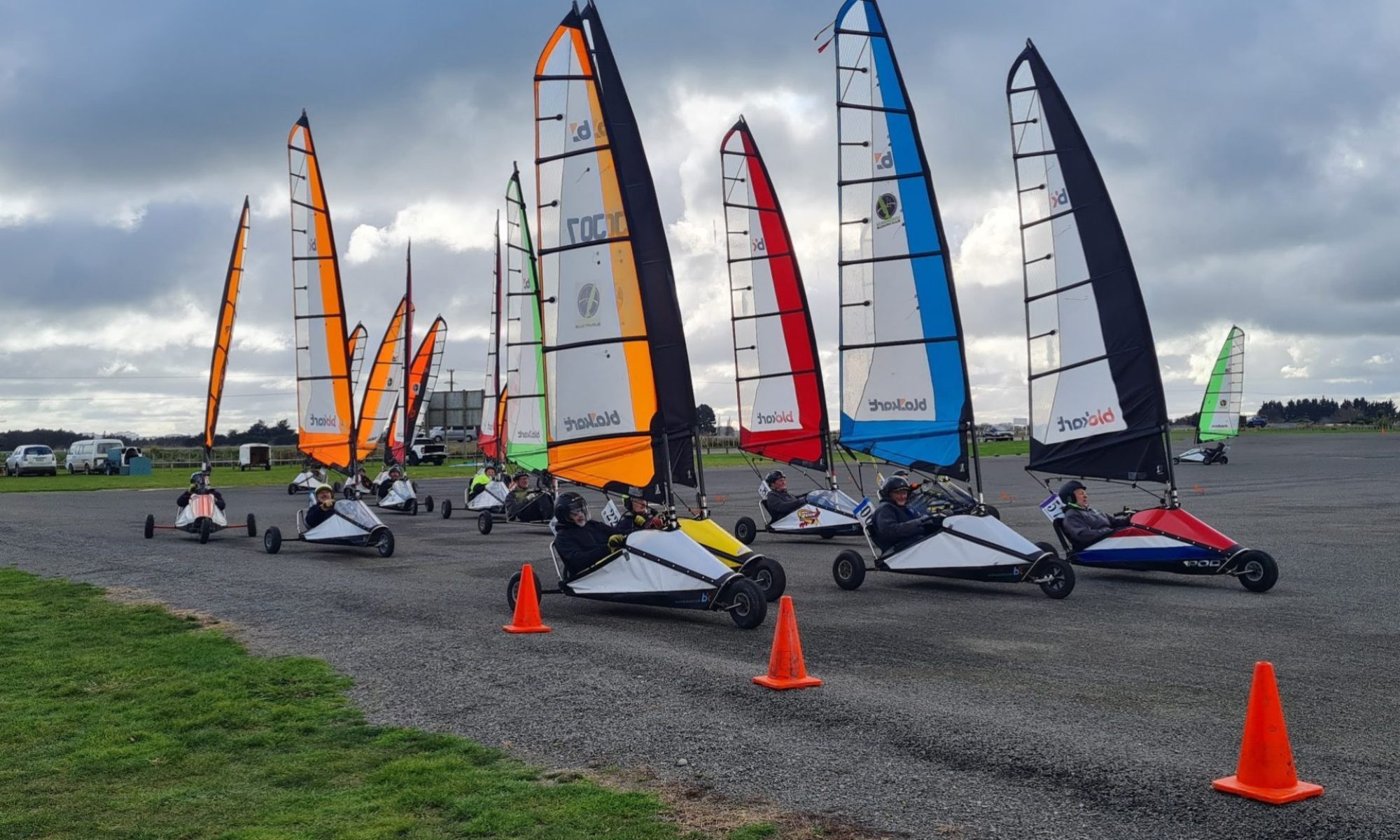Telltales, tufts, indicators, flappers, woollies – a dear child has many names. No matter what you call them, they are an essential aid in steering and trimming.
The telltales make the trimming of the sails and the steering of the blokart® easier. You shouldn’t stick too many telltales on your sails – when sailing, the amount of information streaming in exceeds the capacity of the sailor, so keep it as simple as possible. In this article we explain which telltales are essential and sufficient at the same time. We recommend not having more telltales than that. The telltales in the leech should be made of a rather strong nylon strip. The telltales in the luff should be of woollen yarn glued onto the sail with a colourful sticky-back.
steering tales
The telltales near the luff of the sail are used as a steering aid when sailing upwind. If you are pointing too high the windward telltales “stall”, i.e. point straight up or stream forwards or twirl around restlessly. If you are sailing too low the leeward telltales hang down and die, which is a sign of a serious steering error – the leeward telltales should always stream steadily aft.
The windward telltales indicate different things depending of the wind strength. In light winds your heading is correct when both the windward and leeward telltales stream steadily aft. The maximum speed is achieved by steering so high that the windward telltales are just about to twirl. In medium winds the best speed is achieved when the windward telltales jump up at steady intervals. Telltale 1, telltale 2, telltale 3 – jump – telltale 1…
steering for v.m.g. (velocity made good)
The steering telltales are most useful when sailing upwind. Steering according to the telltales in light and medium conditions normally maximizes VMG, i.e. your speed towards the mark is the greatest. A high VMG does not necessarily mean the highest speedometer values, but indicates the ideal combination of kart speed, pointing and leeway.
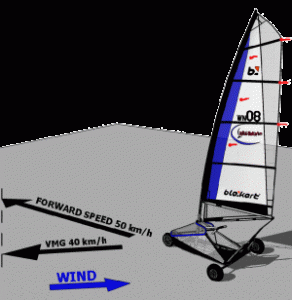
leech tales
You should have two to four telltales on the leech, which used to monitor sheet tension. The leech tails, as well as the telltales for steering, are of the most value in light to medium air. The telltale at the end of the top batten pocket is essential when adjusting the proper twist for the main sail. When the telltale disappears behind the sail, the sheet is too tight and the sail has too little twist. In a light winds (5 to 10 knots) the top telltale should be flying for about half of the time. In less than about five knots the leech tails won’t work properly. When the wind picks up, the sail is flattened and all the telltales normally stream aft.
The two telltales below the top one tell us about the overall shape of the sail. When the top telltale streams steadily aft but the second one is stalling, your sail is either too full in the middle and /or too flat in the top. Bending the mid-section of the mast normally helps.
The main sheet is the most important trimming device on your blokart®, and the top leech tail is the best indicator of the main sheet tension. The required tension on the main sheet depends of the rig size and mast setup you have; use the top leech tail when you are looking for the right trim in different condition. In less than 5 knots of wind adjust the sheet so that the upper tail is visible only sometimes. In medium air the upper tail should show itself about 50% of the time, and in heavy air all leech tails must fly constantly.
on a reach…
… telltales are used for trimming the sail. As you steer the blokart® to the next mark of the course keep trimming the sail so that the telltales stream steadily aft. On a reach the top telltales are good value when determining the right amount of twist, which is otherwise very difficult. If the windward top telltales are stalling, ease the main sheet slightly to increase the sail’s twist. Remember that you can rely on the telltales only in light and medium conditions. In strong winds the heel becomes the main trimming indicator and the excess power has to be released by increasing the twist. Normally it is very difficult to get both the top and bottom telltales to work well together. Don’t use the luff telltales when looking for the right amount of main sheet tension – the information you get is often more harmful than beneficial.
below: If the leeward telltales are stalling or streaming forward, you are sailing too low. Come up a bit, or ease the sheet a bit. In light air, steer just on the verge of collapsing the leeward tails.
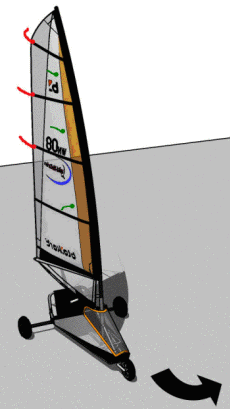
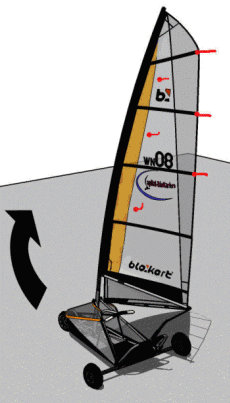
above: If the windward telltales are continuously jumping up but the blokart® isn’t trying to heel excessively, you are sailing too high. In medium air on an ideal heading the telltales jump up at three to four second intervals. In stronger winds (15 knots +) ignore the telltales and steer by the heel angle
Telltales make trimming and steering easier. One should not, however, stare his eyes out at them. If the cut of your sail is too flat, you will achieve the best speed by steering the blokart® so low that the leeward telltales are partly stalling. On the other hand, if your sail is too full (which inevitably happens to all sails at some stage when the wind picks up) you should steer the blokart® so that the windward telltales are twirling up. In strong winds, let the telltales live their own lives and steer the blokart® according to heel and track position.
flow separation & boundary layers
 When the wind sweeps past the sail its velocity near the sail surface decreases because of the friction.
When the wind sweeps past the sail its velocity near the sail surface decreases because of the friction.
This so called boundary layer can be over 30mm thick in the middle on the windward side and in the leech on the leeward side of the sail. When the velocity of the air stream decreases to a certain point the boundary layer separates from the sail. The telltales indicate how the boundary layer is behaving at different moments in different parts of the sail. The separation of the boundary layer always means a significant loss in power and is to be avoided at all cost. This is why the telltales are so useful, and why we try to trim the sail so that they always stream steadily aft.
separation bubbles
The sail is often compared to a wing of an airplane. A sail, however, has one aerodynamic characteristic that makes the comparison feeble. In the luff of a sail the airflow always gets separated from the sail surface on one side or the other, creating a separation bubble. The thick and round leading edge of a wing – or a keel of a sailboat – eliminates the separation of the boundary layer, which improves the efficiency of the foil considerably.
windward side bubble
When the airflow meets the luff of the sail in too steep an angle, it separates and a separation bubble forms. The bubble is like a small eddy where air circulates around in the same spot. The tighter the sail is sheeted the longer the separation bubble will be. The airflow reattaches to the sail behind the separation bubble.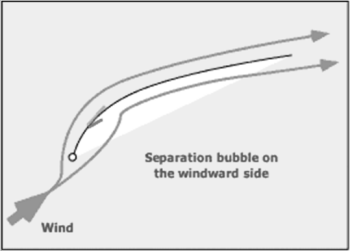
Depending on the size of the bubble and the position of the steering telltales they either stream steadily aft, twirl in a funny way or in the worst case even stream forwards against the wind.
If you are pointing too high the bubble forms on the windward side of the sail. The bubble on the windward side is less harmful than the one on the leeward side; in heavy winds there is always a bubble of some length on the windward side of the sail
smooth flow
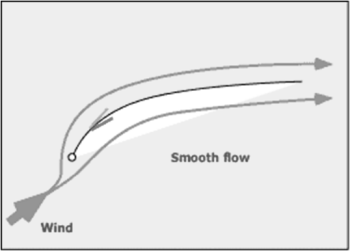
The very luff of the sail nearly always has a separation bubble on one side or the other which is why the telltales shouldn’t be installed too close to the luff. When the sail is sheeted properly and the boat is on its ideal course, the telltales on both sides of the sail stream steadily aft.
In this case, the separation bubble at the luff is then extremely small and alternates from one side to the other. The airflow meets the luff of the sail at an ideal angle and the flow is smooth at both sides of the sail.
leeward side bubble
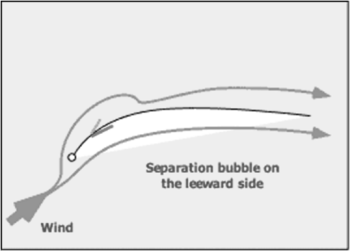
If you are sailing too low, or if the sail is sheeted in too hard, a separation bubble forms on the leeward side. This is very harmful to the performance and should be avoided at all times.
Independently of the luff separation bubble, the airflow may get detached from the sail just before the leech on the leeward side. The eddy formed like this makes the leech telltale disappear behind the sail. For the sake of clarity, the size of the separation bubbles is exaggerated in the drawing.
